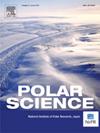Gravity strike angles from EIGEN6C4 to seek conditions favourable for hydrocarbon occurrences in the Arctic zone
IF 1.5
4区 地球科学
Q3 ECOLOGY
引用次数: 0
Abstract
An unusual remote sensing method is employed to seek for the sedimentary areas with possible deposits of oil/gas. The gravity aspects, derived from the global high-resolution gravity field model EIGEN 6C4, namely the strike angles, are used to detect zones on land and off-shore with a higher probability of occurrences of hydrocarbons in the Arctic zone. We utilize our previous experience with the gravity aspects applied for various geological features on the Earth, the Moon, and Mars (everywhere there our knowledge of the gravity field parameters for the respective planet is already sufficient for such a task). The West Siberian basin and Yamal peninsula nearby with known and huge oil/gas resources are used as a test bed demonstrating how our method works. Then, we extrapolate to the Lomonosov Ridge in the Arctic Ocean (till now only with scientific drilling), showing the most promising localities with possible hydrocarbon occurrences. Our results can also be used for speculations about many further untapped places in the Arctic zone with prospective hydrocarbon resources.

利用本征6c4的重力走向角寻找北极地区有利油气赋存的条件
采用一种不同寻常的遥感方法寻找可能有油气沉积的沉积区域。重力方面,来自全球高分辨率重力场模型EIGEN 6C4,即走向角,用于探测北极地区陆地和海上碳氢化合物出现可能性较高的区域。我们利用我们以前在地球、月球和火星的各种地质特征上应用重力方面的经验(在那里,我们对各自行星的重力场参数的知识已经足以完成这样的任务)。西西伯利亚盆地和亚马尔半岛附近已知的巨大油气资源被用作试验平台,展示了我们的方法是如何工作的。然后,我们推断到北冰洋的罗蒙诺索夫海岭(到目前为止只有科学钻探),显示了最有希望发现碳氢化合物的地方。我们的结果也可以用来推测北极地区许多未开发的有潜在碳氢化合物资源的地方。
本文章由计算机程序翻译,如有差异,请以英文原文为准。
求助全文
约1分钟内获得全文
求助全文
来源期刊

Polar Science
ECOLOGY-GEOSCIENCES, MULTIDISCIPLINARY
CiteScore
3.90
自引率
5.60%
发文量
46
期刊介绍:
Polar Science is an international, peer-reviewed quarterly journal. It is dedicated to publishing original research articles for sciences relating to the polar regions of the Earth and other planets. Polar Science aims to cover 15 disciplines which are listed below; they cover most aspects of physical sciences, geosciences and life sciences, together with engineering and social sciences. Articles should attract the interest of broad polar science communities, and not be limited to the interests of those who work under specific research subjects. Polar Science also has an Open Archive whereby published articles are made freely available from ScienceDirect after an embargo period of 24 months from the date of publication.
- Space and upper atmosphere physics
- Atmospheric science/climatology
- Glaciology
- Oceanography/sea ice studies
- Geology/petrology
- Solid earth geophysics/seismology
- Marine Earth science
- Geomorphology/Cenozoic-Quaternary geology
- Meteoritics
- Terrestrial biology
- Marine biology
- Animal ecology
- Environment
- Polar Engineering
- Humanities and social sciences.
 求助内容:
求助内容: 应助结果提醒方式:
应助结果提醒方式:


